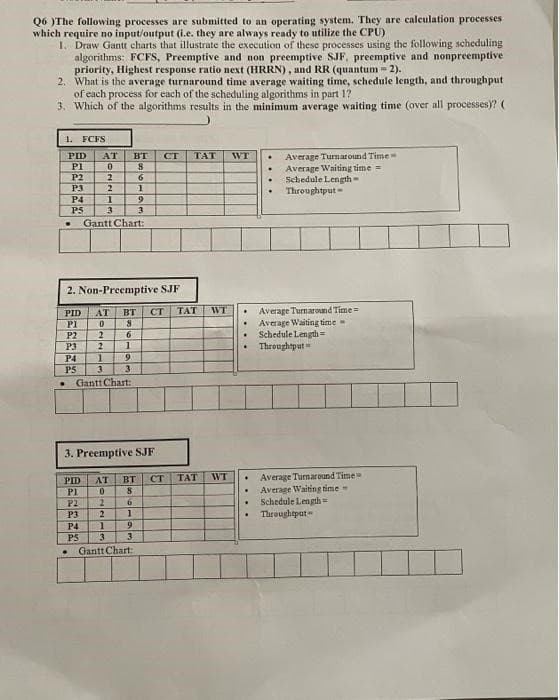Q6 )The following processes are submitted to an operating system. They are calculation processes which require no input/output (i.e. they are always ready to utilize the CPU) 1. Draw Gantt charts that illustrate the execution of these processes using the following scheduling algorithms: FCFS, Preemptive and non preemptive SJF, preemptive and nonpreemptive priority, Highest response ratio next (HRRN), and RR (quantum-2). 2. What is the average turnaround time average waiting time, schedule length, and throughput of each process for each of the scheduling algorithms in part 17 3. Which of the algorithms results in the minimum average waiting time (over all processes)? ( 1. FCFS PID AT BT PI 0 S P2 2 . P3 P4 P5 . 2 P3 2 P4 1 PS 3 2 1 3 Gantt Chart: 2. Non-Preemptive SJF PID AT BT CT TAT WT 0 S Pl P2 6 HERREX PID AT PI 0 3 Gantt Chart: . P2 2 61 3. Preemptive SJF P3 2 P4 1 PS 3 9 6 1 BT 8 6 1 9 3 9 3 Gantt Chart: CT TAT WT CT TAT WT . . Average Turnaround Time- Average Waiting time => Schedule Length- Throughtput- Average Turnaround Time= Average Waiting time - Schedule Length= Throughput Average Turnaround Time Average Waiting time- Schedule Length Throughtpat-
Q6 )The following processes are submitted to an operating system. They are calculation processes which require no input/output (i.e. they are always ready to utilize the CPU) 1. Draw Gantt charts that illustrate the execution of these processes using the following scheduling algorithms: FCFS, Preemptive and non preemptive SJF, preemptive and nonpreemptive priority, Highest response ratio next (HRRN), and RR (quantum-2). 2. What is the average turnaround time average waiting time, schedule length, and throughput of each process for each of the scheduling algorithms in part 17 3. Which of the algorithms results in the minimum average waiting time (over all processes)? ( 1. FCFS PID AT BT PI 0 S P2 2 . P3 P4 P5 . 2 P3 2 P4 1 PS 3 2 1 3 Gantt Chart: 2. Non-Preemptive SJF PID AT BT CT TAT WT 0 S Pl P2 6 HERREX PID AT PI 0 3 Gantt Chart: . P2 2 61 3. Preemptive SJF P3 2 P4 1 PS 3 9 6 1 BT 8 6 1 9 3 9 3 Gantt Chart: CT TAT WT CT TAT WT . . Average Turnaround Time- Average Waiting time => Schedule Length- Throughtput- Average Turnaround Time= Average Waiting time - Schedule Length= Throughput Average Turnaround Time Average Waiting time- Schedule Length Throughtpat-
Database System Concepts
7th Edition
ISBN:9780078022159
Author:Abraham Silberschatz Professor, Henry F. Korth, S. Sudarshan
Publisher:Abraham Silberschatz Professor, Henry F. Korth, S. Sudarshan
Chapter1: Introduction
Section: Chapter Questions
Problem 1PE
Related questions
Question

Transcribed Image Text:Q6 )The following processes are submitted to an operating system. They are calculation processes
which require no input/output (i.e. they are always ready to utilize the CPU)
1. Draw Gantt charts that illustrate the execution of these processes using the following scheduling
algorithms: FCFS, Preemptive and non preemptive SJF, preemptive and nonpreemptive
priority, Highest response ratio next (HRRN), and RR (quantum = 2).
2.
What is the average turnaround time average waiting time, schedule length, and throughput
of each process for each of the scheduling algorithms in part 1?
3. Which of the algorithms results in the minimum average waiting time (over all processes)? (
1. FCFS
PID AT BT
0
P1
8
P2
6
P3
P4
P5
Pl
P2
P3
2. Non-Preemptive SJF
PID AT BT CT TAT
0
8
2
2
1
1
9
3
3
Gantt Chart:
6
1
P4
1
9
P5 3 3
Gantt Chart:
.
2
.
2
3. Preemptive SJF
PID
PL
P2
P3
1
P4
1 9
PS 3 3
Gantt Chart:
BT
0 8
12
6
AT
2
CT TAT WT
CT
ΤΑΊ
WT
WT
Average Turnaround Time-
Average Waiting time =
Schedule Length-
Throughtput-
.
Average Turnaround Time=
Average Waiting time
Schedule Length=
Throughput
Average Turnaround Time
. Average Waiting time-
Schedule Length=
Throughtpat
Expert Solution
This question has been solved!
Explore an expertly crafted, step-by-step solution for a thorough understanding of key concepts.
Step by step
Solved in 2 steps

Knowledge Booster
Learn more about
Need a deep-dive on the concept behind this application? Look no further. Learn more about this topic, computer-science and related others by exploring similar questions and additional content below.Recommended textbooks for you

Database System Concepts
Computer Science
ISBN:
9780078022159
Author:
Abraham Silberschatz Professor, Henry F. Korth, S. Sudarshan
Publisher:
McGraw-Hill Education

Starting Out with Python (4th Edition)
Computer Science
ISBN:
9780134444321
Author:
Tony Gaddis
Publisher:
PEARSON

Digital Fundamentals (11th Edition)
Computer Science
ISBN:
9780132737968
Author:
Thomas L. Floyd
Publisher:
PEARSON

Database System Concepts
Computer Science
ISBN:
9780078022159
Author:
Abraham Silberschatz Professor, Henry F. Korth, S. Sudarshan
Publisher:
McGraw-Hill Education

Starting Out with Python (4th Edition)
Computer Science
ISBN:
9780134444321
Author:
Tony Gaddis
Publisher:
PEARSON

Digital Fundamentals (11th Edition)
Computer Science
ISBN:
9780132737968
Author:
Thomas L. Floyd
Publisher:
PEARSON

C How to Program (8th Edition)
Computer Science
ISBN:
9780133976892
Author:
Paul J. Deitel, Harvey Deitel
Publisher:
PEARSON

Database Systems: Design, Implementation, & Manag…
Computer Science
ISBN:
9781337627900
Author:
Carlos Coronel, Steven Morris
Publisher:
Cengage Learning

Programmable Logic Controllers
Computer Science
ISBN:
9780073373843
Author:
Frank D. Petruzella
Publisher:
McGraw-Hill Education